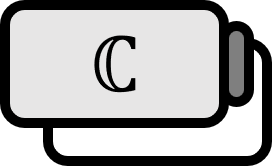The Relationship between Trigonometric and Hyperbolic Functions in Complex Analysis
Definition 1
Let’s define the hyperbolic function as a complex function $\sinh, \cosh : \mathbb{C} \to \mathbb{C}$ as follows. $$ \sinh z := { {e^{z} - e^{-z}} \over 2 } \\ \cosh z := { {e^{z} + e^{-z}} \over 2 } $$
Theorem 2
$$ \begin{align*} \sinh (iz) =& i \sin z \\ \sin (iz) =& i \sinh z \\ \cosh (iz) =& \cos z \\ \cos (iz) =& \cosh z \end{align*} $$
Description
The most confusing part when first encountering the hyperbolic function is ‘why such a definition is used’. In the realm of real numbers, trigonometric functions are defined as ratios in a unit circle, while hyperbolic functions are represented as a linear combination of exponential functions. Just by definitions, it’s hard to accept why hyperbolic functions are called a kind of trigonometric function. Only by observing these functions over complex numbers can one understand how well-structured and intuitive this system is.
These properties are somewhat aligned with the original properties used in trigonometric functions.
Sine function is an odd function, Cosine function is an even function
$$ \sin (-\theta) = - \sin \theta \\ \cos (-\theta) = \cos \theta $$
Just as $-1$ freely moves in and out of $\sin$ without affecting $\cos$, $i$ moves freely in and out of $\sin$ and $\sinh$ without affecting $\cos$ and $\cosh$. The difference is whether it’s $\sin$ or $\cos$, the presence of $\text{h}$ toggles. Thinking of complex numbers creating a world not of just negative or positive but of $i$ and $-i$, one might realize the necessity of moving beyond merely $\sin$ or $\cos$ to include $\sinh$ and $\cosh$.
Periodicity of Hyperbolic Functions
$$ \sinh (ix) = i \sin x \\ \cosh (ix) = \cos x $$
Moreover, the relationship between trigonometric and hyperbolic functions easily reveals the periodicity of hyperbolic functions in pure imaginary numbers. It’s straightforward once considered, but such a property might be elusive when not familiar.
Proof
In complex analysis of trigonometric functions: $$ \sin z = { {e^{iz} - e^{-iz}} \over 2 i } \\ \cos z = { {e^{iz} + e^{-iz}} \over 2 } $$
$$ \sinh (iz) = { { e^{iz} - e^{-iz} } \over 2 } = i { { e^{iz} - e^{-iz} } \over {2 i} } = i \sin z $$
$$ \sin (iz) = { {e^{iiz} - e^{-iiz}} \over 2 i } = - i { {e^{-z} - e^{z}} \over 2 } = i \sinh z $$
$$ \cosh (iz) = { { e^{iz} + e^{-iz} } \over 2 } = \cos z $$
$$ \cos (iz) = { { e^{iiz} + e^{-iiz} } \over 2 } = { { e^{-z} + e^{z} } \over 2 } = \cosh z $$
■
